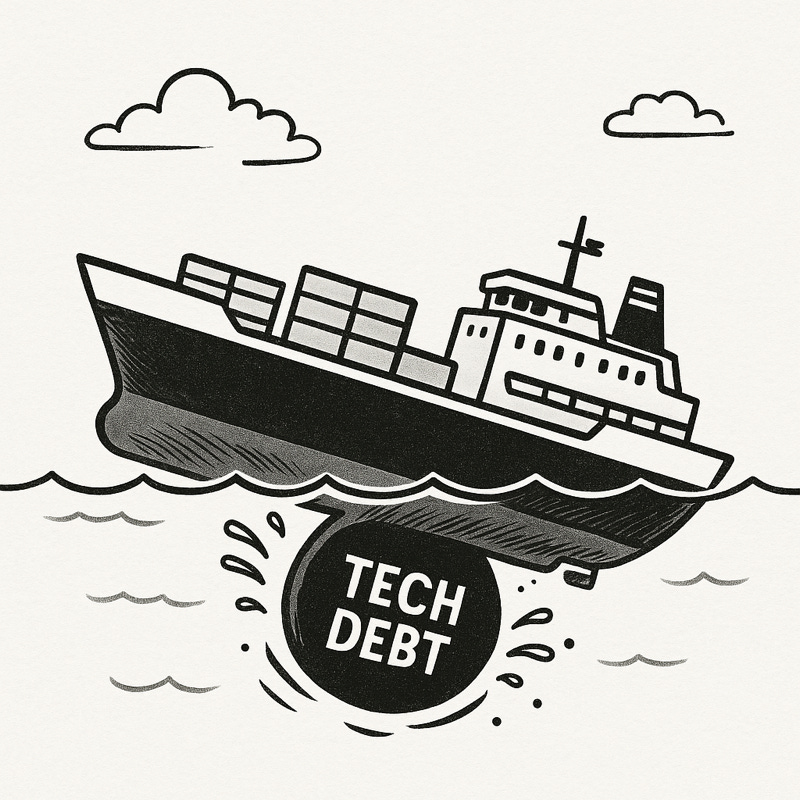Your Tech Debt Is Sinking the Ship. Here’s How to Patch the Hull.
The simple math that turns a nagging ‘cost’ into your biggest strategic advantage.
Your best engineers are quitting and your product roadmap is a fantasy. The culprit isn’t your strategy; it’s the invisible anchor of technical debt you’re pretending isn’t there, dragging your business to the bottom. Let’s be blunt: calling this an ‘engineering problem’ isn’t really going to cut the muster.
Technical debt isn’t just messy code. It’s a business liability—an insidious tax on every feature you build. It’s the collection of shortcuts and outdated tech that makes your systems slow, brittle, and terrifying to change. Ignore it, and you’re not just slowing down; you’re charting a course straight to Davy Jones’s Locker.
(Guess who was watching Pirates of the Caribbean this weekend whilst writing this article? :))
Stay with me on the pirates theme - it might be fun ….
The Black Spot: Recognising the Warning Signs
Pirates got the Black Spot as a death sentence. You get vague status updates and missed deadlines. The signs are different, but the outcome is the same: you’re finished. You don’t need to be a developer to see them. You just need to stop making excuses. Are you seeing these in your organisation?
Glacial Pace: Simple requests take months, not weeks. Your teams give you vague timelines because they’re terrified of what they’ll break in the codebase.
Talent Exodus: Your best engineers—the ones who want to build, not patch—are spending their days fighting fires. They’re disengaged, frustrated, and their LinkedIn profiles are suddenly very active.
The Ticking Time Bomb: There’s a critical piece of infrastructure everyone is afraid to touch. It’s essential, but it’s a house of cards. This isn’t a technical quirk; it’s a business-ending event waiting to happen.
The Six-Month Onboarding: It takes a new engineer half a year to become productive because your system is an undocumented maze. You are paying a full salary for half the output. Period.
If this sounds familiar, you’ve already received the Black Spot. The only question is what you’ll do before the bill comes due.
Ten Years Before the Mast: The True Cost of Neglect
Ignoring the debt is like being cursed to serve on a ghost ship: you’re constantly rowing, but you never make progress. The cost isn’t a line item; it’s a slow, grinding tax on your entire operation. I’ve seen this play out in Fortune 500s and scrappy startups alike. The cost always manifests in three ways:
Velocity Decay: A team that shipped five major features a year now struggles to ship two. Why? For every hour they spend on new work, they spend three navigating the wreckage of the old.
Innovation Extinction: Your competitors are launching products with modern tools while you’re stuck maintaining a system from a decade ago. You can’t play offense because your foundation is built on sand.
The Kraken: This is the catastrophic failure you tell yourself won’t happen. The security breach that erases customer trust. The system-wide outage on your biggest sales day. The Kraken is what happens when years of small compromises coalesce into one business-ending event.
Stop telling your teams to ‘just work harder.’ They’re already rowing against the current. The problem isn’t their effort; it’s the broken ship you’ve given them.
The Executive Bargain: Pay Now or Pay More Later
There’s a way out, but it requires a conscious decision to sacrifice short-term speed for long-term survival. This isn’t just ‘refactoring.’ This is a business investment in future velocity.
I can hear the objection: ‘We don’t have time for this.’ Wrong.
This isn’t a scheduling conflict; it’s a priority problem
Saying you don’t have time to address technical debt is like a sailor saying they’re too busy bailing water to patch the hole. The time you ‘save’ today is borrowed at an extortionate interest rate from your future.
Stop framing this as a cost. Start framing it as a strategic enabler.
When you talk to your board, anchor your argument in data. Don’t say, ‘We need to fix our old code.’ Say this:
“Industry benchmarks, like Google’s DORA reports and studies from McKinsey, show that elite-performing organisations spend up to 50% less time on rework. Right now, we are operating with a self-imposed 40% velocity tax due to legacy systems. By investing 15% of our capacity over the next six months to pay down this debt, we will increase feature delivery speed by 30% by Q4. This lets us beat Competitor X to market.”
One is a chore. The other is a winning move. That is the bargain: a deliberate sacrifice now for overwhelming power later.
Charting Your Course: A Dead-Simple Framework
Don’t let your teams boil the ocean. You need a simple system to navigate out of the depths. Stop talking and start doing. Use this 3-step framework now.
1. Map the Treacherous Waters
You can’t fight what you can’t see. Conduct a ‘Debt Audit.’ Get your senior engineers in a room for one day—no excuses. Their task is to map every major piece of technical debt and categorise it:
Level 1 (The Shallows): Annoying. Slows things down but won’t sink you.
Level 2 (The Deep): Significant business risk. Actively blocks new work.
Level 3 (The Abyss): Existential threat. A failure here is a Kraken-level event.
2. Make the Pain Visible with This One Metric
To get this problem onto an executive dashboard, track one thing: Feature Cycle Time—the total time from the start of work to customer delivery. When you see the cycle time for simple tasks ballooning, you have hard data. The conversation changes from a ‘feeling’ to a ‘fact.’ You can walk into the boardroom and say: “A simple button change took four weeks instead of four days. Our debt is costing us 90% of our speed on basic tasks.”
3. Make It a First-Class Citizen
Technical debt work does not live in a forgotten backlog. It belongs on the main product roadmap, right next to revenue-generating features. Use a simple ratio. The ‘2-for-1 Rule’ works: for every two new features, the team resolves one piece of Level 2 or 3 debt. This makes the tradeoff explicit and forces consistent progress.
Rally the Crew: Getting Your Team Onboard
A map is useless if the crew won’t sail. A top-down mandate will fail. You need to earn buy-in from the very engineers who feel the pain of tech debt most acutely.
Communicate the ‘Why’: Frame this initiative not as ‘cleaning up messes’ but as ‘unleashing our talent.’ Explain how this investment will allow them to build faster, innovate more, and spend less time on frustrating work. Connect their efforts directly to the business outcomes you outlined for the board.
Address Scepticism Head-On: Your best engineers have heard promises before. They might see this as another short-lived initiative. Acknowledge this by empowering them. Give each team a dedicated debt budget—15-20% of their capacity each sprint—and the autonomy to use it on the problems they know are most critical. This isn’t a top-down mandate; it’s bottom-up ownership.
Celebrate Early Wins: When a team pays down a piece of debt and it directly leads to a faster feature release, broadcast that victory. Showcase the ‘before and after’ cycle times. This creates a powerful feedback loop, builds momentum, and proves to the entire organisation that this is not just another corporate exercise.
Your Escape Route Starts Now
Stop treating technical debt as your engineering team’s secret shame. It is a predictable, manageable business risk. Ignoring it is not a strategy; it’s a slow-motion surrender.
Your journey out of Davy Jones’s Locker begins with a single question. This week, walk into your Head of Engineering’s office and ask: ‘What is the one piece of technical debt that, if we eliminated it, would have the biggest positive impact on our velocity?’
Their answer is your starting point. That’s the first X on your new treasure map—a direct path to higher velocity and a happier crew. Go dig.
Thanks for reading. If this article resonated with you, here are three ways to go deeper:
🎧 Listen: This article was inspired by insights from my Future of Work podcast.
📬 Subscribe: Join 2,400+ leaders on my newsletter for weekly frameworks.
🤝 Partner: I help executives turn technical debt into a strategic advantage. Book a call.
P.S. Next week I’m diving into “You Are the Product Owner of You”. Subscribe so you don’t miss it.*



